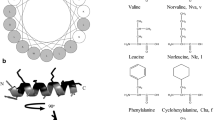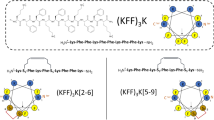Abstract
Amphipathic α-helical peptides (AHPs) have shown potential as a therapeutic approach against multi-drug-resistant bacterial infections due to their broad-spectrum antimicrobial activity by disrupting bacterial membranes. However, their nonspecific interactions with membranes often result in cytotoxicity toward mammalian cells. Previous studies have shown that a PxxP motif near the middle of cathelicidin-derived antimicrobial peptides contributes to potent and selective antibacterial activity. In this study, we compared KL18 with KL-PxxP to examine the effects of the central PxxP motif in AHPs on their structure, antibiotic activity, and mode of action. In a membrane-mimetic environment, we observed that KL18 had a much higher helical content compared to KL-PxxP. In aqueous buffer, KL18 adopted a highly ordered α-helical conformation, while KL-PxxP exhibited a disordered conformation. We found that KL-PxxP exhibited 4–16 times higher antibacterial activity than KL18 and significantly reduced the hemolytic activity. These findings suggest that the dynamic conformational behaviors caused by the central PxxP motif conferred the antibacterial selectivity of AHPs. Additionally, KL-PxxP showed strong binding to anionic liposomes and weak binding to zwitterionic liposomes, explaining its selectivity for bacteria over mammalian cells. Despite having a low ability to dissipate the bacterial membrane potential, KL-PxxP translocated efficiently across lipid membranes. Therefore, we propose that the central PxxP motif in AHPs provides dynamic conformational behavior in aqueous and membrane-mimetic environments, enhances binding to anionic membranes, and facilitates translocation across lipid bilayers, resulting in improved antibacterial potency and selectivity. Understanding the unique structural characteristics and functional roles of the PxxP motif in the antimicrobial mechanism of action holds great potential for advancing the development of novel peptide antibiotics.
Similar content being viewed by others
Introduction
The proliferation of antibiotic-resistant microorganisms has led to global health issues, prompting significant efforts to develop novel antimicrobial agents to combat these infections (Haney et al. 2019; Molton et al. 2013; Zaman et al. 2017). Among the major structural types of antimicrobial peptides, amphipathic α-helical peptides (AHPs) have emerged as a promising class of antimicrobial agents due to their effective activity against a broad range of bacterial pathogens (Mant et al. 2019; Matos et al. 2023; Tossi et al. 2000; Zhang and Gallo 2016; Zhang et al. 2021). While the antimicrobial effectiveness of AHPs is influenced by its multifaceted mode of action beyond mere membrane permeability, comprehending the molecular-level interaction between AHPs and lipid bilayers holds significant importance for the development of antimicrobial drugs.
In summary, our study found that KL-PxxP has significantly enhanced antibacterial activity compared to KL18, while also displaying reduced hemolytic activity. KL-PxxP had a lower helical content than KL18 in a membrane-mimetic environment. We observed that KL-PxxP is distributed randomly while KL18 is self-associated in buffer. Importantly, KL-PxxP had a strong affinity for anionic liposomes and efficiently translocated across lipid bilayers despite its low ability to dissipate the bacterial membrane potential. Therefore, our findings suggest that the central PxxP motif in AHPs provides dynamic conformational behavior in both aqueous and membrane-mimetic environments, enhancing binding to anionic membranes and translocation across lipid bilayers, resulting in improved antibacterial potency and selectivity. This study sheds light on the structural and functional aspects of the central PxxP motif in AHPs, which holds promise as an approach to enhance antimicrobial efficacy while mitigating the cytotoxic effects against mammalian cells. Furthermore, we propose that this motif could be applied to other antimicrobial peptides to facilitate the development of peptides with intracellular targets and the creation of multifunctional antimicrobial peptides.
Availability of data and materials
Not applicable.
References
Amos SBTA, Vermeer LS, Ferguson PM, Kozlowska J, Davy M, Bui TT, Drake AF, Lorenz CD, Mason AJ.Antimicrobial peptide potency is facilitated by greater conformational flexibility when binding to gram-negative bacterial inner membranes (vol 6, 37639, 2016). Sci Rep. 2018; 8
Avci FG, Akbulut BS, Ozkirimli E. Membrane Active peptides and their biophysical characterization. Biomolecules. 2018;8:77.
Biswaro LS, da Costa Sousa MG, Rezende TMB, Dias SC, Franco OL. Antimicrobial peptides and nanotechnology, recent advances and challenges. Front Microbiol. 2018;9:855.
Chen C, Chen Y, Yang C, Zeng P, Xu H, Pan F, Lu JR. High selective performance of designed antibacterial and anticancer peptide amphiphiles. ACS Appl Mater Interfaces. 2015;7:17346–55.
de Breij A, Riool M, Cordfunke RA, Malanovic N, de Boer L, Koning RI, Ravensbergen E, Franken M, van der Heijde T, Boekema BK et al. The antimicrobial peptide SAAP-148 combats drug-resistant bacteria and biofilms. Sci Transl Med. 2018;10.
Hadianamrei R, Tomeh MA, Brown S, Wang J, Zhao X. Rationally designed short cationic alpha-helical peptides with selective anticancer activity. J Colloid Interface Sci. 2022;607:488–501.
Haney EF, Straus SK, Hancock REW. Reassessing the host defense peptide landscape. Front Chem. 2019;7:43.
Henriques ST, Melo MN, Castanho MA. Cell-penetrating peptides and antimicrobial peptides: How different are they? Biochem J. 2006;399:1–7.
Joodaki F, Martin LM, Greenfield ML. Computational study of helical and helix-hinge-helix conformations of an anti-microbial peptide in solution by molecular dynamics and vibrational analysis. J Phys Chem B. 2021;125:703–21.
Juretic D, Simunic J. Design of alpha-helical antimicrobial peptides with a high selectivity index. Expert Opin Drug Discov. 2019;14:1053–63.
Kabelka I, Vacha R. Advances in molecular understanding of alpha-helical membrane-active peptides. Acc Chem Res. 2021;54:2196–204.
Kumar P, Kizhakkedathu JN, Straus SK. Antimicrobial peptides: diversity, mechanism of action and strategies to improve the activity and biocompatibility in vivo. Biomolecules. 2018;8:4.
Lee H, Lim SI, Shin SH, Lim Y, Koh JW, Yang S. Conjugation of cell-penetrating peptides to antimicrobial peptides enhances antibacterial activity. ACS Omega. 2019;4:15694–701.
Lee H, Yang S. Dimerization of cell-penetrating buforin II enhances antimicrobial properties. J Anal Sci Technol. 2021;12:1–7.
Liu L, Fang Y, Wu JH. Flexibility is a mechanical determinant of antimicrobial activity for amphipathic cationic alpha-helical antimicrobial peptides. BBA-Biomembranes. 2013;1828:2479–86.
Lohner K. Membrane-active antimicrobial peptides as template structures for novel antibiotic agents. Curr Top Med Chem. 2016;17:508–19.
Lu Y, Bai J, Tan D, Chen T, Shan A. The effects of hinge structure on the biological activity of antimicrobial peptides and its application in molecular design: a review. Sheng Wu Gong Cheng Xue Bao. 2021;37:3142–50.
Ma Z, Yang J, Han JZ, Gao L, Liu HX, Lu ZX, Zhao HZ, Bie XM. Insights into the antimicrobial activity and cytotoxicity of engineered alpha-helical peptide amphiphiles. J Med Chem. 2016;59:10946–62.
Mant CT, Jiang ZQ, Gera L, Davis T, Nelson KL, Bevers S, Hodges RS. De novo designed amphipathic alpha-helical antimicrobial peptides incorporating dab and dap residues on the polar face to treat the gram-negative pathogen, Acinetobacter baumannii. J Med Chem. 2019;62:3354–66.
Matos GM, Garcia-Teodoro B, Martins CP, Schmitt P, Guzman F, de Freitas ACO, Stoco PH, Ferreira FA, Stadnik MJ, Robl D, et al. Antimicrobial spectrum of activity and mechanism of action of linear alpha-helical peptides inspired by shrimp anti-lipopolysaccharide factors. Biomolecules. 2023;13:150.
Molton JS, Tambyah PA, Ang BS, Ling ML, Fisher DA. The global spread of healthcare-associated multidrug-resistant bacteria: a perspective from Asia. Clin Infect Dis. 2013;56:1310–8.
Moravej H, Moravej Z, Yazdanparast M, Heiat M, Mirhosseini A, Moghaddam MM, Mirnejad R. Antimicrobial peptides: features, action, and their resistance mechanisms in bacteria. Microb Drug Resist. 2018;24:747–67.
Muller AT, Posselt G, Gabernet G, Neuhaus C, Bachler S, Blatter M, Pfeiffer B, Hiss JA, Dittrich PS, Altmann KH, et al. Morphing of amphipathic helices to explore the activity and selectivity of membranolytic antimicrobial peptides. Biochemistry. 2020;59:3772–81.
Nam HY, Choi J, Kumar SD, Nielsen JE, Kyeong M, Wang S, Kang D, Lee Y, Lee J, Yoon MH, et al. Helicity modulation improves the selectivity of antimicrobial peptoids. ACS Infect Dis. 2020;6:2732–44.
Park SC, Son H, Kim YM, Lee JK, Park S, Lim HS, Lee JR, Jang MK. Design of antimicrobial peptides with cell-selective activity and membrane-acting mechanism against drug-resistant bacteria. Antibiotics (Basel). 2022;11:1619.
Sansom MS, Weinstein H. Hinges, swivels and switches: the role of prolines in signalling via transmembrane alpha-helices. Trends Pharmacol Sci. 2000;21:445–51.
Sato H, Felix JB. Peptide-membrane interactions and mechanisms of membrane destruction by amphipathic alpha-helical antimicrobial peptides. BBA-Biomembranes. 2006;1758:1245–56.
Shai Y. Mechanism of the binding, insertion and destabilization of phospholipid bilayer membranes by alpha-helical antimicrobial and cell non-selective membrane-lytic peptides. Biochim Biophys Acta. 1999;1462:55–70.
Tossi A, Sandri L, Giangaspero A. Amphipathic, alpha-helical antimicrobial peptides. Biopolymers. 2000;55:4–30.
Tuerkova A, Kabelka I, Kralova T, Sukenik L, Pokorna S, Hof M, Vacha R. Effect of helical kink in antimicrobial peptides on membrane pore formation. Elife. 2020;9:e47946.
Xu W, Zhu X, Tan T, Li W, Shan A. Design of embedded-hybrid antimicrobial peptides with enhanced cell selectivity and anti-biofilm activity. PLoS ONE. 2014;9:e98935.
Yang ST, Jeon JH, Kim Y, Shin SY, Hahm KS, Kim JI. Possible role of a PXXP central hinge in the antibacterial activity and membrane interaction of PMAP-23, a member of cathelicidin family. Biochemistry. 2006a;45:1775–84.
Yang ST, Lee JY, Kim HJ, Eu YJ, Shin SY, Hahm KS, Kim JI. Contribution of a central proline in model amphipathic alpha-helical peptides to self-association, interaction with phospholipids, and antimicrobial mode of action. Febs J. 2006b;273:4040–54.
Yang ST, Shin SY, Hahm KS, Kim JI. Different modes in antibiotic action of tritrpticin analogs, cathelicidin-derived Trp-rich and Pro/Arg-rich peptides. Biochim Biophys Acta. 2006c;1758:1580–6.
Yang S, Lee CW, Kim HJ, Jung HH, Kim JI, Shin SY, Shin SH. Structural analysis and mode of action of BMAP-27, a cathelicidin-derived antimicrobial peptide. Peptides. 2019;118:170106.
Yang ST, Shin SY, Shin SH. The central PXXP motif is crucial for PMAP-23 translocation across the lipid bilayer. Int J Mol Sci. 2021;22:9752.
Yokoo H, Hirano M, Ohoka N, Misawa T, Demizu Y. Structure-activity relationship study of amphipathic antimicrobial peptides using helix-destabilizing sarcosine. J Pept Sci. 2021;27:e3360.
Zaman SB, Hussain MA, Nye R, Mehta V, Mamun KT, Hossain N. A review on antibiotic resistance: alarm bells are ringing. Cureus. 2017;9:e1403.
Zhang LJ, Gallo RL. Antimicrobial peptides. Curr Biol. 2016;26:R14–9.
Zhang SK, Song JW, Gong F, Li SB, Chang HY, **e HM, Gao HW, Tan YX, Ji SP. Design of an alpha-helical antimicrobial peptide with improved cell-selective and potent anti-biofilm activity. Sci Rep. 2016;6:27394.
Zhang QY, Yan ZB, Meng YM, Hong XY, Shao G, Ma JJ, Cheng XR, Liu J, Kang J, Fu CY. Antimicrobial peptides: mechanism of action, activity and clinical potential. Military Med Res. 2021;8:1–25.
Acknowledgements
The authors thank Industry-Academic Cooperation Foundation, Chosun University.
Funding
The present study was supported by research funds from the Institute of Medical Science, Chosun University, Republic of Korea, 2021.
Author information
Authors and Affiliations
Contributions
HL and SY performed experiments: All authors designed research, analyzed data, and wrote the paper.
Corresponding authors
Ethics declarations
Competing interests
The authors declare no competing financial interests.
Additional information
Publisher's Note
Springer Nature remains neutral with regard to jurisdictional claims in published maps and institutional affiliations.
Rights and permissions
Open Access This article is licensed under a Creative Commons Attribution 4.0 International License, which permits use, sharing, adaptation, distribution and reproduction in any medium or format, as long as you give appropriate credit to the original author(s) and the source, provide a link to the Creative Commons licence, and indicate if changes were made. The images or other third party material in this article are included in the article's Creative Commons licence, unless indicated otherwise in a credit line to the material. If material is not included in the article's Creative Commons licence and your intended use is not permitted by statutory regulation or exceeds the permitted use, you will need to obtain permission directly from the copyright holder. To view a copy of this licence, visit http://creativecommons.org/licenses/by/4.0/.
About this article
Cite this article
Lee, H., Yang, S. & Shin, SH. Effect of central PxxP motif in amphipathic alpha-helical peptides on antimicrobial activity and mode of action. J Anal Sci Technol 14, 33 (2023). https://doi.org/10.1186/s40543-023-00398-x
Received:
Accepted:
Published:
DOI: https://doi.org/10.1186/s40543-023-00398-x




